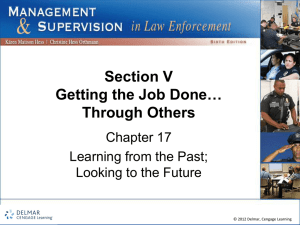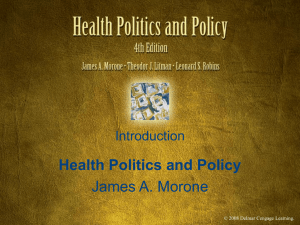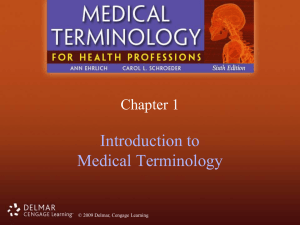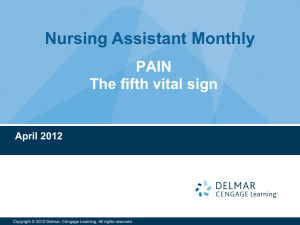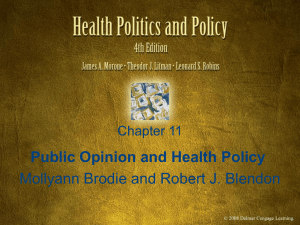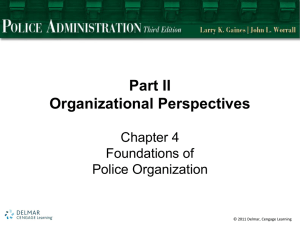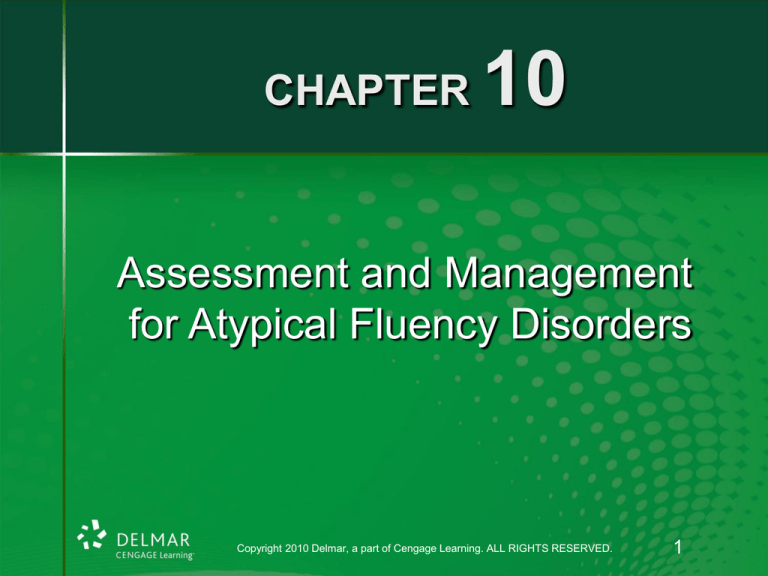
CHAPTER
10
Assessment and Management
for Atypical Fluency Disorders
Copyright 2010 Delmar, a part of Cengage Learning. ALL RIGHTS RESERVED.
1
Cluttering
Neurogenic stuttering
Psychogenic stuttering
Copyright 2010 Delmar, a part of Cengage Learning. ALL RIGHTS RESERVED.
2
Definitions of cluttering
Revised (DSM-III-R) (1987):
The essential feature of cluttering is a disturbance
of fluency involving an abnormally rapid rate and
erratic rhythm of speech that impedes intelligibility.
Faulty phrasing patterns are usually present so that
there are bursts of speech consisting of groups of
words that are not related to the grammatical
structure of the sentence. The affected person is
usually unaware of any communication impairment.
(pp. 85–86)
Copyright 2010 Delmar, a part of Cengage Learning. ALL RIGHTS RESERVED.
3
Definitions of cluttering
(continued)
St. Louis and Rustin (1992)
. . .a speech-language disorder, characterized by
abnormal fluency that is not stuttering and a speech rate
that is rapid, irregular, or both. (p. 299)
Daly’s (1992)
. . . a disorder of speech and language processing
resulting in rapid, disrhythmic, sporadic, unorganized,
and frequently unintelligible speech. Accelerated speech
is not always present, but an impairment in formulating
language almost always is. (p. 107) (Figure 10-1,
Linguistic disfluency model)
Copyright 2010 Delmar, a part of Cengage Learning. ALL RIGHTS RESERVED.
4
Cluttering as a cognitive-linguistic problem:
De-emphasizing rapid speech rate
(Daly and Burnett, 1999) (Figure 10-1)
A person who clutters will exhibit at least one
disturbance in each of the 5 dimensions:
• Cognitive—total lack of awareness of cluttering, poor
attention span, poor auditory memory.
• Language—expressive & receptive difficulties, poor
readers, little interest in music or literature.
• Pragmatics—poor turn-taking, introducing, maintaining,
and ending a conversation.
• Speech—irregular rate, accelerations, sporadic bursts,
variable intensity, poor rhythm.
• Motor—clumsy and uncoordinated, impulsive motor
movements.
Copyright 2010 Delmar, a part of Cengage Learning. ALL RIGHTS RESERVED.
5
Characteristics of cluttering
The most basic features
• Excessive rate & uneven rate (missing
sounds and syllables)
• Inattention to grammatical details
• Delayed speech & language development
• Poor reading comprehension
• Immature/inappropriate responses
• Unorganized writing
Copyright 2010 Delmar, a part of Cengage Learning. ALL RIGHTS RESERVED.
6
An example of cluttered writing
F. Myers and P. Kissagizlis, ISAD Conference,
2007
Copyright 2010 Delmar, a part of Cengage Learning. ALL RIGHTS RESERVED.
7
Cluttering: A writing sample
Copyright 2010 Delmar, a part of Cengage Learning. ALL RIGHTS RESERVED.
8
Myers & Kissagizlis, 2007
Example of “unguarded typing”
After years of feeling insecure, differnt, isolated
and excluded, I know Kknow the comndition I
have, which is clutteroimng, although it is not
cured and nebver can be as fra as I am aware,
at lwast I am aware of the conditini aadn people
wil learn from tihs, and poepke who sufer as I
do wil be able t undrestand what they ahve, the
amin thinsg is, peiopokle worlkd wide awil be
able to reecognise the condition and maybe the
ptofessionals can impement a suitable
treainhg/teacjhing athen evebntaualy a
treatment regime.
Copyright 2010 Delmar, a part of Cengage Learning. ALL RIGHTS RESERVED.
9
Other features
• Fluency breaks are not SLDs—unfinished words,
revisions, repetitions of words and phrases
• Few accessory or coping behaviors
• Unaware of their unintelligible speech
• Unaware of listener reaction
• Monitoring results in better speech
• May be stuttering-cluttering (20–30%)
• Pure cluttering occurs ~ 5%
Copyright 2010 Delmar, a part of Cengage Learning. ALL RIGHTS RESERVED.
10
Distinguishing
cluttering & stuttering
• Stutterers know what they want to say but are interfered
in their attempt to produce various words, whereas
clutterers do not necessarily know all of what they want to
say, or how, but say it anyway. (St. Louis et al., 2007)
• Fluency breaks are not those typically produced by
individuals who stutter (i.e., part-word repetitions,
monosyllabic word repetition, and dysrhythmic
phonations), but rather take the form of interjections,
unfinished words, revisions, repetitions. (St. Louis et al.,
2007)
• A clutterer is not likely to associate fear or avoidance with
specific sounds or words.
Copyright 2010 Delmar, a part of Cengage Learning. ALL RIGHTS RESERVED.
11
A rate-regulatory problem:
Acoustic and spectrographic analysis
• An acoustic analysis of cluttered speech
by Martin, Kroll, O’Keefe, and Painter
(1983) indicated:
• a lack of distinct vowel formant structure, release
of energy for stop bursts, and aperiodic fricative
energy.
• Substitutions and distortions of phonemes such
as /s/, /r/, or /l/ have also been noted.
Copyright 2010 Delmar, a part of Cengage Learning. ALL RIGHTS RESERVED.
12
A rate-regulatory problem:
Acoustic and spectrographic analysis
(continued)
• Baker, Raphael, Myers, and St. Louis’s (2000)
spectrographic analysis found:
• although listeners perceived C’s speech rate as
extremely fast, the number of syllables/s fell
within the normal range.
• Rate perceived as rapid due to the omission of
many sounds and syllables.
• Clutterers produce conversational speech at a
rate faster than their systems can handle.
Copyright 2010 Delmar, a part of Cengage Learning. ALL RIGHTS RESERVED.
13
Accompanying characteristics
Clutterers often reported to possess
•
•
•
•
ADHD—distractibility, inattention to detail, lack of
follow through.
Learning disabilities—poor handwriting and musical
abilities.
Apraxia—more pronounced during production of
longer, more complex words.
Some reports of Tourette’s Syndrome, autism,
Asperger, pervasive developmental delay, OCD.
Copyright 2010 Delmar, a part of Cengage Learning. ALL RIGHTS RESERVED.
14
St. Louis, Myers, Faragasso,
Townsend, & Gallaher (2004)
• 48 listeners rated two young male speakers who cluttered across 5
attributes:
• Naturalness, articulation, language, disfluency, and rate.
• Listeners used 9-point equal-appearing interval scales.
• Score of 1 represented “highly natural” or “excellent”
• Score of 9 represented “highly unnatural” or “very poor”
• Listeners found attributes of rate and naturalness to be least
acceptable, followed by speaker’s articulation. Most acceptable were
fluency and language.
• Results supported concept that a distinguishable characteristic of
cluttered speech is the rapid and irregular rate of speech.
Copyright 2010 Delmar, a part of Cengage Learning. ALL RIGHTS RESERVED.
15
Assessment
• Cluttering Assessment Program (freeware on SHP)
• Computer-based tool with 2 tracks for indicating
severity:
•
•
1st track—computation of % of talking time cluttered
or noncluttered from individual or cumulative
samples
2nd track—visual analog scaling procedure, listener
rates speaker on 9 dimensions: speaking rate, rate
regularity, disfluency, syllable production integrity,
overall articulation
Copyright 2010 Delmar, a part of Cengage Learning. ALL RIGHTS RESERVED.
16
Assessment (continued)
• Computer based tool with 2 tracks for indicating severity
(Continued):
accuracy, naturalness, pragmatic language
appropriateness, language coherence, and thought
organization.
• Self-Awareness of Speech Index (Table 10-1)
• 14-item measure provided criterion-referenced indication of a
speaker’s lack of awareness of their own speech
characteristics.
• Includes: oral motor problems /general coordination,
handwriting, central auditory problems, reading
comprehension, spelling, and math skills
Copyright 2010 Delmar, a part of Cengage Learning. ALL RIGHTS RESERVED.
17
Assessment & progress
• St. Louis et al., (2007)
Table 10-2, Clinical Signs of Diagnostic Significance
• Daly (2006)
Figure 10-3, Predictive Cluttering Inventory (PCI)
• Daly (2006)
Figure 10-4, Cluttering Treatment Profile Analysis
Copyright 2010 Delmar, a part of Cengage Learning. ALL RIGHTS RESERVED.
18
Assessment & progress (continued)
Predictive Cluttering Inventory (PCI) (Daly, 2006)
• 33-item checklist of 4 speaker characteristics
• Pragmatics, 10 statements
• Speech-Motor, 10 items
• Language-Cognition, 8 items
• Motor Coordination-Writing Problems, 5 items
Copyright 2010 Delmar, a part of Cengage Learning. ALL RIGHTS RESERVED.
19
Assessment & progress (continued)
• Listeners rate frequency of occurrence: ALWAYS (6
points), NEVER (0 points)
• Scores of >120 Pure Clutterer; 80-120 CluttererStutterer
• Most frequent characteristics of cluttering: omits,
transposition of sounds and syllables; and lack of
effective, sufficient self-monitoring skills.
Copyright 2010 Delmar, a part of Cengage Learning. ALL RIGHTS RESERVED.
20
Possible problems during
• Speaker’s Lack of awareness of
• Rate
• Inability to effectively communicate
• Denial/resistance
• Other personality characteristics
• Compulsivity, poor concentration, pragmatic
issues, intolerance of interruptions
Copyright 2010 Delmar, a part of Cengage Learning. ALL RIGHTS RESERVED.
21
Other treatment issues
• In extreme cases
• Immature responses, short temper, history of
emotional problems
• Appears defensive/antagonistic
• Unable to tolerate slower rate
• However, when able to monitor
• Dramatically improve fluency and intelligibility
• Make appropriate alterations even without
instruction
Copyright 2010 Delmar, a part of Cengage Learning. ALL RIGHTS RESERVED.
22
Other treatment issues
(continued)
• With multidimensional characteristics of speakers the
clinician is likely to consult with psychologists,
neurologists
• Regardless of selected technique, all authors stress
daily practice and support of family, friends, and
support groups.
Copyright 2010 Delmar, a part of Cengage Learning. ALL RIGHTS RESERVED.
23
Cluttering
3 basic treatment principles
• Frequent repetition of therapy goals and rationale will
be necessary.
• Clinician should provide immediate and direct
feedback.
• Parents and significant others should play a major
part in providing feedback, correction, and
reinforcement.
Copyright 2010 Delmar, a part of Cengage Learning. ALL RIGHTS RESERVED.
24
Treatment recommendations
(Meyers, 1992; Louis and Myers, 1995)
The underlying goal of treatment is to help the
speaker to enhance the synchrony of language
formulation and the rate of speech production.
Primary emphasis is on enhancing the
coordination of the linguistic and articulatory levels
in order to prevent “derailment” of the speech
sequence at either of these levels. Another key
element is increased awareness by the speaker of
the excessive rate or “haste” associated with both
linguistic organization and motoric/articulatory
production.
Copyright 2010 Delmar, a part of Cengage Learning. ALL RIGHTS RESERVED.
25
Treatment techniques
• Several stuttering modification/fluency-shaping
techniques can be used to increase awareness
and aid rate and fluency changes
• Many activities (particularly when written or
verbalized) can server a variety of functions
across categories
(see pp. 508–510 in text)
Copyright 2010 Delmar, a part of Cengage Learning. ALL RIGHTS RESERVED.
26
Acquired stuttering
Neurogenic Stuttering
Psychogenic Stuttering
Copyright 2010 Delmar, a part of Cengage Learning. ALL RIGHTS RESERVED.
27
Acquired stuttering (continued)
• Occurs for the first time in adults following
years of normally fluent speech (mean onset in
40s)
• The possibility of relapse (after successful Tx),
or overt characteristics of speakers who
managed it in a covert “interiorized” manner
• Likely to have rapid onset
• Can be difficult to diagnose, especially in
distinguishing neurogenic from psychogenic
Copyright 2010 Delmar, a part of Cengage Learning. ALL RIGHTS RESERVED.
28
Characteristics of neurogenic
stuttering
Characteristics that MAY Occur for Speakers with
Neurogenic Stuttering
•
•
•
•
•
No reported history of previous fluency problems.
Evidence of sudden progressive degrading speaker’s
CNS.
Fluency-enhancing techniques do not result in
significantly improved fluency.
Fluency does not improve during automatic speech
tasks.
There is a tendency for stuttering to occur on medial
and final syllables of words.
Copyright 2010 Delmar, a part of Cengage Learning. ALL RIGHTS RESERVED.
29
Characteristics of neurogenic
stuttering (continued)
• Compared to developmental stutterers there is less of
tendency to demonstrate:
•
•
•
improved fluency w/repeated readings of a
passage.
variability in fluency across speech tasks or
speaking situations.
struggle behavior, emotional reactions, and
secondary behaviors, particularly at the onset of
the problem.
Copyright 2010 Delmar, a part of Cengage Learning. ALL RIGHTS RESERVED.
30
Characteristics of neurogenic
stuttering (continued)
• Higher occurrence in males
• May be suddenly or unambiguously associated
w/head trauma, stroke, cryosurgery, drug usage, or
anoxia.
• The association with neurological damage is less
obvious with slowly degraded fluency
• Other terms: late or adult onset, cortical stuttering,
organic stuttering, SAAND (Stuttering Associated
with Acquired Neurological Disorders)
Copyright 2010 Delmar, a part of Cengage Learning. ALL RIGHTS RESERVED.
31
Caution during assessment
• Although individuals with neurogenic stuttering have
some unique characteristics, Van Borsal (1997)
cautions that clinical symptoms alone are not
adequate to distinguish from developmental
stuttering.
• De Nil et al. (2007)
• Generalized criteria don’t provide specificity for individual
speakers who’ve acquired fluency problems from particular
insults or disease processes
• Exceptions to identifying characteristics used in past
• Medial & Final vs. Initial
• Lack of secondary behaviors and anxiety/emotion
Copyright 2010 Delmar, a part of Cengage Learning. ALL RIGHTS RESERVED.
32
Neurogenic stuttering: Assessment
Two Unique Characteristics
•
Relative ineffectiveness of fluency-enhancing
techniques that tend to immediately eliminate
stuttering for most people w/developmental
stuttering (e.g., choral speaking, whispering,
singing)
•
More likely than those w/developmental
stuttering to produce disfluencies during
automatic speech tasks such as counting,
naming days of week, etc.
Copyright 2010 Delmar, a part of Cengage Learning. ALL RIGHTS RESERVED.
33
Neurogenic stuttering: Assessment
(continued)
• Assessment needs to be thorough & individualized
• Table 10-3, De Nil et al. (2007), Assessment Battery
for Acquired Stuttering in Adults (ABASA)
•
•
•
•
Case history
General communication functions
Speech fluency assessment
Speaker self-assessment of attitudes
Copyright 2010 Delmar, a part of Cengage Learning. ALL RIGHTS RESERVED.
34
Treatment procedures: Neurogenic
• Not all individuals with neurogenic forms of disfluenices will
require treatment
• Stroke patients often recover over a period of weeks of months
• Closed head trauma resulting from seizures often improve
once seizures subside
• Parkinson’s patients are more responsive to treatment than
stroke patients
• Fluency-shaping and stuttering-modification techniques
typically used
Copyright 2010 Delmar, a part of Cengage Learning. ALL RIGHTS RESERVED.
35
Characteristics of psychogenic
stuttering
• The rarest form of fluency problem; most people
with developmental stuttering do not have
emotional problems
• Possible for rapid improvement with treatment
(counseling and traditional fluency therapy)
• May show bizarre struggle or anxiety behavior
• Stuttering may be situation specific
• Unusual grammar, bizarre speech & movements
• Psychopathology not always present
Copyright 2010 Delmar, a part of Cengage Learning. ALL RIGHTS RESERVED.
36
Psychogenic stuttering
• Conversion reaction related to anxiety and
depression
• Case history information especially important
• History of emotional or neurological problems?
• Appear to be “holding on” to stuttering (miming)
• Rapid reduction in stuttering following diagnosis or
treatment
• Rapid improvement after disclosing emotionally
sensitive information
• Worsening of behavior with less difficult tasks
Copyright 2010 Delmar, a part of Cengage Learning. ALL RIGHTS RESERVED.
37
Treatment options
• Traditional treatment, possibly with a psychologist or
counselor
• Rule out organic causation
• Changing the speaker’s belief system (Baumgartner
& Duffy, 1997); changing the way they think about the
problem is more important than producing fluent
speech
Copyright 2010 Delmar, a part of Cengage Learning. ALL RIGHTS RESERVED.
38
Treatment
• Baumgartner says that goals should be “open-ended”
because there are so many different behaviors exhibited
• Focus on reducing struggle behavior on days that you
are not seeing improvement
• Don’t rush the speaker to do certain tasks.
• As treatment continues show the speaker how to
expand his/her fluency.
• Baumgartner and Duffy (1997) reported that more than
50% of patients improved to a normal range of fluency
after 1–2 sessions
Copyright 2010 Delmar, a part of Cengage Learning. ALL RIGHTS RESERVED.
39
Distinguishing between neurogenic
and psychogenic stuttering
• Many overlapping features of neurogenic and
psychogenic stuttering
• Conduct a “psychologic interview,” and look at
communicative difficulties in the speaker’s
present or past situations
• Look for signs of CNS impairment
• Remember, there are more reported cases of
neurogenic stuttering than psychogenic
stuttering.
Copyright 2010 Delmar, a part of Cengage Learning. ALL RIGHTS RESERVED.
40
The possibility of malingering
Two types:
• Pure—intentional faking all symptoms of a
physical or mental disorder
• Partial—exaggerating existing symptoms
• Both of these are used to achieve a form of gain or
advantage (e.g., defense in robbery trial)
Copyright 2010 Delmar, a part of Cengage Learning. ALL RIGHTS RESERVED.
41
Determining malingering
(See accounts by Bloodstein, 1988; Seery, 2005;
Shirkey, 1987)
• To assess this, many speaking samples
were collected in different situations, a full
case history was evaluated, and indirect
tests of malingering stuttering were
performed
• Instances of unusual consistency (vs. typical
variability) of stuttering.
Copyright 2010 Delmar, a part of Cengage Learning. ALL RIGHTS RESERVED.
42

